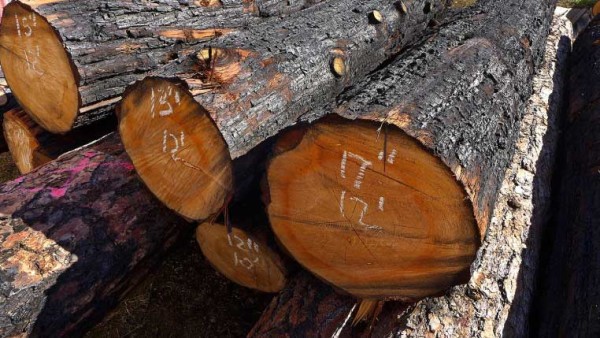
Rescued Local Pine
Drought, historic wildfires, and an epidemic of bark beetles have savaged the Sierra Nevada mountains of California, leaving behind forests of Standing Dead trees. The wood is salvaged and “rescued” from rotting uselessly on the forest floor or adding further fuel to future fires, thereby maintaining a sense of conservation even when the wood is newly cut down. Creating beautiful finished lumber from these trees is the best and most environmentally sound use of Standing Dead Pine.
US Forest Service and CAL FIRE surveys predicted that by the end of the 2016 summer, 70 to 80 percent of our local Pine trees were dead from Western Pine Beetles. The die-off is so huge, the amount of material that is rescued to make lumber represents less than one percent of the die-off.
Finished Product from Rescued Local Pine
Finished lumber from local Standing Dead Ponderosa and Sugar Pine is most commonly used for siding and paneling. When high durability is not required, occasionally this Western Pine softwood is used for flooring.
Using this beautiful material will enhance your home or business and is environmentally responsible at the same time.
Blue Stain Rescued Pine
Rescued Pine often develops a blue streaking that makes beautiful paneling with depth of color. Ponderosa Pine has a golden yellow color. Sugar Pine has a creamier color.
Rescued Pine lumber may contain one sixteenth to a quarter inch oblong holes where the Pine Beetles entered the tree.
Small to large darker knots may be present. Clear lumber is also available.
Rescued Pine has a lower price per square foot than our other recycled lumber.
Dead and Standing Pine
Western Pine Beetle Kill: Severe drought conditions in our Sierra Nevada Mountains are leaving many of our local trees weak and stressed, perfect hosts for the Western Bark Beetle.
This epidemic is escalating so quickly, it seems a new patch of brown appears on our once-perfect mountains daily. Many local residents are cutting down their Standing Dead trees to reduce the risk of fire.
Wildfire Kill: In 2014, there were four substantial wildfires near our town of North Fork. (The State of the Sierra Nevada’s Forests Click to download PDF.)
These burned trees become secondary hazards. Once dead they rot. Limbs or whole trees can then fall. Especially near homes and structures, this poses a risk to life and property.
Because these standing burned trees will eventually rot and fall, timely removal for use as lumber makes good environmental sense.

Taking Action
These dead trees (if left standing or on the ground) can propel a routine forest fire into a high-intensity wildfire that causes severe devastation.
CRL has taken action to procure these logs for lumber before they rot and turn into wildfire fuel.
We here at CRL feel that this is the most environmentally appropriate action to take, and call the lumber from these trees “rescued”.

